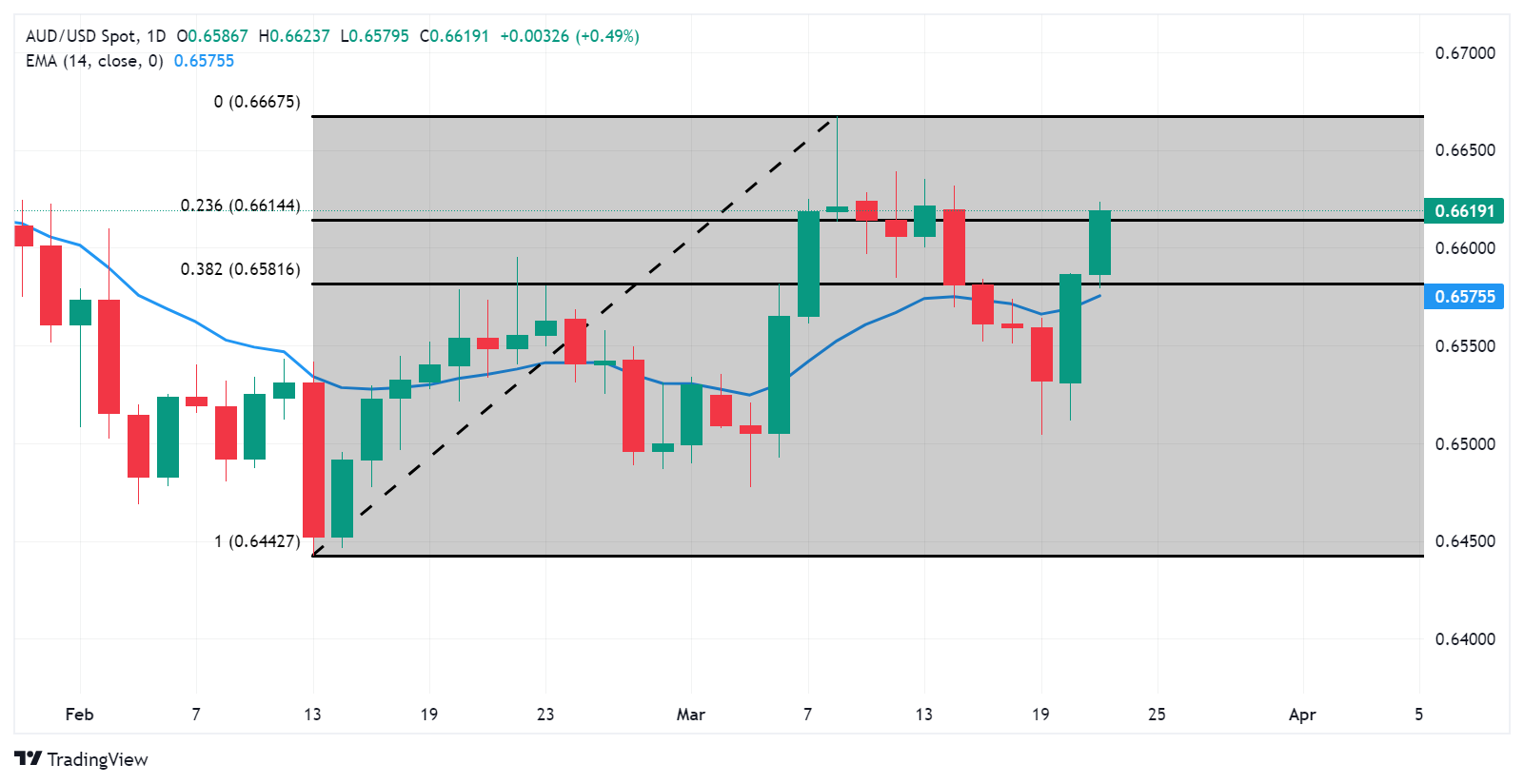- Australian Dollar extends gains on positive economic data from Australia.
- Australian Employment Change surged to 116.5K in February, exceeding expectations of 40.0K.
- US Dollar weakens following the Fed's reaffirmation of expectations for three interest rate cuts in 2024.
The Australian Dollar (AUD) continued its upward momentum for the second consecutive session on Thursday, likely buoyed by positive employment data from Australia. Concurrently, the US Dollar (USD) saw a significant decline following the Federal Open Market Committee's (FOMC) decision to maintain rates at 5.5% during Wednesday's policy meeting. This decision provided support for the AUD/USD pair. Furthermore, remarks made by US Federal Reserve (Fed) Chair Jerome Powell in the post-meeting press conference, signaling a dovish stance, exerted additional downward pressure on the Greenback.
The Australian equity market surrendered its intraday gains and slipped into negative territory. This could limit the AUD's advance. However, earlier in the trading day, the ASX 200 Index surged by nearly 1.0%, aligning with a rally on Wall Street from the previous session.
The US Dollar Index (DXY) exhibited a gap down on Thursday following its significant decline in the preceding session. Weaker US Treasury yields contributed to the losses in the US Dollar, which were likely influenced by the Fed's reaffirmation of expectations for three interest rate cuts in 2024.
Daily Digest Market Movers: Australian Dollar appreciates on positive market sentiment
- Australian Employment Change for February surged to 116.5K, surpassing expectations of 40.0K and the previous figure of 15.3K.
- Australia’s Unemployment Rate increased by 3.7%, lower than the anticipated 4.0% and the previous 4.1%.
- The preliminary Judo Bank Services PMI rose to 53.5, up from the previous figure of 53.1.
- Judo Bank Composite PMI showed a slight increase, reaching 52.4 compared to the previous 52.1.
- People’s Bank of China (PBoC) has kept its interest rate unchanged at 3.45%.
- Chinese Foreign Minister Wang Yi met Australia's Foreign Affairs Minister Penny Wong. The Chinese side emphasized their substantial potential. They stressed that China-Australia relations are progressing positively and urged against any hesitation, deviation, or reversal in this forward momentum.
- During the FOMC Press Conference, Fed Chair Jerome Powell emphasized that although inflation is showing signs of moderation, the persistence of price growth remains a significant concern that the Fed cannot ignore.
- US Building Permits (MoM) increased to 1.518 million in February, against the expected 1.495 million and 1.489 million prior.
- US Housing Starts (MoM) rose to 1.521M from the previous figure of 1.374M, exceeding the market expectation of 1.425M in February.
- The preliminary US Michigan Consumer Sentiment Index for March decreased to 76.5 from 76.9. This decline contrasts with expectations of it remaining unchanged.
Technical Analysis: Australian Dollar advances to near 0.6620 followed by a major barrier
The Australian Dollar trades near 0.6620 on Thursday. Notably, a key resistance level stands at 0.6650, a significant marker for potential upward movement. A successful breakthrough above this level could provide momentum for the AUD/USD pair to revisit March's high, recorded at 0.6667 on March 8. On the downside, immediate support is observed at the 23.6% Fibonacci retracement level of 0.6614, followed by the psychological barrier of 0.6600. Should the pair breach below the latter, it may face further downward pressure, potentially navigating toward the region surrounding the 38.2% Fibonacci retracement at 0.6581 and the 14-day Exponential Moving Average (EMA) positioned at 0.6575.
AUD/USD: Daily Chart
Australian Dollar price today
The table below shows the percentage change of Australian Dollar (AUD) against listed major currencies today. Australian Dollar was the strongest against the Japanese Yen.
| USD | EUR | GBP | CAD | AUD | JPY | NZD | CHF | |
| USD | 0.00% | 0.04% | -0.07% | -0.44% | 0.18% | -0.10% | -0.01% | |
| EUR | -0.01% | 0.03% | -0.07% | -0.45% | 0.15% | -0.09% | -0.02% | |
| GBP | -0.04% | -0.03% | -0.09% | -0.46% | 0.13% | -0.12% | -0.03% | |
| CAD | 0.05% | 0.06% | 0.09% | -0.38% | 0.21% | -0.03% | 0.04% | |
| AUD | 0.44% | 0.44% | 0.47% | 0.38% | 0.60% | 0.36% | 0.44% | |
| JPY | -0.16% | -0.18% | -0.15% | -0.26% | -0.61% | -0.26% | -0.18% | |
| NZD | 0.10% | 0.10% | 0.13% | 0.04% | -0.35% | 0.28% | 0.11% | |
| CHF | 0.00% | -0.02% | 0.02% | -0.07% | -0.48% | 0.18% | -0.11% |
The heat map shows percentage changes of major currencies against each other. The base currency is picked from the left column, while the quote currency is picked from the top row. For example, if you pick the Euro from the left column and move along the horizontal line to the Japanese Yen, the percentage change displayed in the box will represent EUR (base)/JPY (quote).
Australian Dollar FAQs
One of the most significant factors for the Australian Dollar (AUD) is the level of interest rates set by the Reserve Bank of Australia (RBA). Because Australia is a resource-rich country another key driver is the price of its biggest export, Iron Ore. The health of the Chinese economy, its largest trading partner, is a factor, as well as inflation in Australia, its growth rate and Trade Balance. Market sentiment – whether investors are taking on more risky assets (risk-on) or seeking safe-havens (risk-off) – is also a factor, with risk-on positive for AUD.
The Reserve Bank of Australia (RBA) influences the Australian Dollar (AUD) by setting the level of interest rates that Australian banks can lend to each other. This influences the level of interest rates in the economy as a whole. The main goal of the RBA is to maintain a stable inflation rate of 2-3% by adjusting interest rates up or down. Relatively high interest rates compared to other major central banks support the AUD, and the opposite for relatively low. The RBA can also use quantitative easing and tightening to influence credit conditions, with the former AUD-negative and the latter AUD-positive.
China is Australia’s largest trading partner so the health of the Chinese economy is a major influence on the value of the Australian Dollar (AUD). When the Chinese economy is doing well it purchases more raw materials, goods and services from Australia, lifting demand for the AUD, and pushing up its value. The opposite is the case when the Chinese economy is not growing as fast as expected. Positive or negative surprises in Chinese growth data, therefore, often have a direct impact on the Australian Dollar and its pairs.
Iron Ore is Australia’s largest export, accounting for $118 billion a year according to data from 2021, with China as its primary destination. The price of Iron Ore, therefore, can be a driver of the Australian Dollar. Generally, if the price of Iron Ore rises, AUD also goes up, as aggregate demand for the currency increases. The opposite is the case if the price of Iron Ore falls. Higher Iron Ore prices also tend to result in a greater likelihood of a positive Trade Balance for Australia, which is also positive of the AUD.
The Trade Balance, which is the difference between what a country earns from its exports versus what it pays for its imports, is another factor that can influence the value of the Australian Dollar. If Australia produces highly sought after exports, then its currency will gain in value purely from the surplus demand created from foreign buyers seeking to purchase its exports versus what it spends to purchase imports. Therefore, a positive net Trade Balance strengthens the AUD, with the opposite effect if the Trade Balance is negative.
Information on these pages contains forward-looking statements that involve risks and uncertainties. Markets and instruments profiled on this page are for informational purposes only and should not in any way come across as a recommendation to buy or sell in these assets. You should do your own thorough research before making any investment decisions. FXStreet does not in any way guarantee that this information is free from mistakes, errors, or material misstatements. It also does not guarantee that this information is of a timely nature. Investing in Open Markets involves a great deal of risk, including the loss of all or a portion of your investment, as well as emotional distress. All risks, losses and costs associated with investing, including total loss of principal, are your responsibility. The views and opinions expressed in this article are those of the authors and do not necessarily reflect the official policy or position of FXStreet nor its advertisers. The author will not be held responsible for information that is found at the end of links posted on this page.
If not otherwise explicitly mentioned in the body of the article, at the time of writing, the author has no position in any stock mentioned in this article and no business relationship with any company mentioned. The author has not received compensation for writing this article, other than from FXStreet.
FXStreet and the author do not provide personalized recommendations. The author makes no representations as to the accuracy, completeness, or suitability of this information. FXStreet and the author will not be liable for any errors, omissions or any losses, injuries or damages arising from this information and its display or use. Errors and omissions excepted.
The author and FXStreet are not registered investment advisors and nothing in this article is intended to be investment advice.
Recommended content
Editors’ Picks

EUR/USD tumbles to three-week lows near 1.0750
Fresh headlines mentioning the imminence of US tariffs on the European Union put EUR/USD under heavy pressure and send it to the area of multi-week lows around 1.0750 on Wednesday.

GBP/USD retests the 1.2870 zone, or two-week lows
The Greenback's upside impulse is now gathering extra steam and motivates GBP/USD to recede to the area of new two-week troughs around 1.2870.

Gold remains slightly offered just above $3,000
Gold is trading in a narrow range on Wednesday but continues to hold firm just above the $3,000 mark. The precious metal is drawing support from upbeat sentiment in the broader commodities space, buoyed by Copper’s surge to a fresh all-time high earlier in the day.

Bitcoin holds $87,000 as markets brace for volatility ahead of April 2 tariff announcements
Bitcoin (BTC) holds above $87,000 on Wednesday after its mild recovery so far this week. A K33 Research report explains how the markets are relatively calm and shaping up for volatility as the market absorbs the tariff announcements.

Sticky UK services inflation shows signs of tax hike impact
There are tentative signs that the forthcoming rise in employer National Insurance is having an impact on service sector inflation, which came in a tad higher than expected in February. It should still fall back in the second quarter, though, keeping the Bank of England on track for three further rate cuts this year.

The Best brokers to trade EUR/USD
SPONSORED Discover the top brokers for trading EUR/USD in 2025. Our list features brokers with competitive spreads, fast execution, and powerful platforms. Whether you're a beginner or an expert, find the right partner to navigate the dynamic Forex market.
